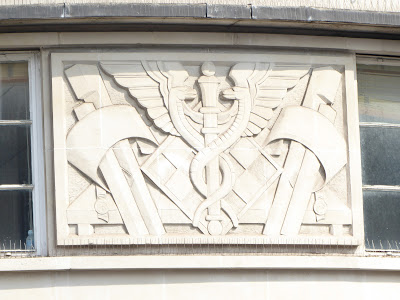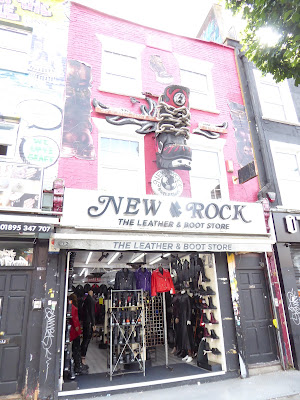
Here I am at the 22nd station that I've visited on the Northern Line. As with the previous stations it opened in June 1907 as the Charing Cross, Euston and Hampstead Railway as part of the Underground Electric Railways Co of London.

At platform level there are the distinctive red and cream tiles with the name of the station featured in tiles. The station was completed a year before the roundel design was adopted as the Underground brand in 1908. That is why the station name is on the platform walls. Some say the name was derived from the white farmhouses that dotted the region. Chalk was a common material used to whitewash buildings. Others think the name comes from the Old English word
Caldecote meaning ' cold cottage' which would be a refuge for strangers or isolated dwelling. By the 16th century
Caldecote had become
Chalcott and by 1746 it was known as
Chalk.
In the booking hall you can see some of the original green tiling made by W B Simpson and Sons. This pomegranate design can be found in a number of stations.
The station was designed by Leslie Green
(1875-1908), who designed more than 40 underground stations. The wedge shaped station has the longest frontage of any of Green's stations. In the 1980s the frontage was used on the cover of 'Absolutely', an album by the band 'Madness'.
The distinctive red glazed terracotta tiling is a feature of all of Green's stations. Other features include the semi circular windows and the small round windows in between.

The word
UNDERGROUN
D with the larger first and last letters dates back to 1908.
Chalk Farm is less than a ten minute walk from the previous station at Camden so I decided to begin my visit by walking back towards Camden and where I finished my last walk at the Stables market which is halfway between the two stations. In 1820 after the successful completion of the Regents Canal, Camden became an important transport hub which grew throughout the industrial era
Originally this market would have housed working horses, the horse master and feed.
By the end of the 1800s, Camden Good Yards housed around 800 horses across various stable blocks. All of the building now houses retail outlets. These stairs were once the backdrop for the Clash's first album in 1977. At that time their studio was part of the stable complex.
As the work of these horses became more vital better living and stabling were introduced. A double level stable was built accessible by this curved ramp.
The horse tunnels provided the working horses with safe passage under the railway tracks that intersected their stables. the horses were used to collect and move goods amongst the various yards. At their most industrious time as much space was allocated to the horses as was allocated to the trains.
To avoid cutting the Regents canal in half the railway tracks had to be raised above the canal.on brick built structures supported by arches. These arches provided areas of storage and in the late 1800s were rented by Gilbey's, a wine and spirit importer. Nowadays they are used by various retail outlets.
Also located in the Stables market is this bronze statue of Amy Winehouse. It was sculpted by Scott Eaton and was unveiled in 2014, three years after her death. Amy Winehouse ( 1983-2011) was a British singer and songwriter who was strongly associated with this area until her death in 2011 at her home nearby in Camden Square. She died of alcohol poisoning. Whilst in Spain last month I met someone who had come all the way to London to see this statue. He was thrilled to have seen it. I suppose if you are a huge fan then you are willing to travel any distance to see the area where your hero used to live and perform.


Probably the most famous building in Chalk Farm is The Roundhouse. It has a fascinating history having been commissioned by Robert Stephenson, considered the greatest engineer of the 19th cent. He designed and built 'The Rocket' in 1829. Although the Rocket was not the first steam locomotive, it was the first to bring together several innovations making it the most advanced of its day.
The Roundhouse was originally built as the Great Circular Engine House for the purpose of turning around the steam engines for the London and Birmingham railway. It opened in 1847 and consisted of 24 bays as well as the turntable. Once engines had been turned they could be rolled out to a bay for either servicing or storage. Each bay had an inspection pit to allow engineers to work underneath the engines. By 1870 it was considered too small as the trains were now far too big for the turntable and the bays.

The empty building was then purchased by Gilbey's Gin and for the next 80 years was used as their main distillery, warehouse and depot. In the 1960s the building was bought by the Greater London Council to create a cultural centre. It became one of London's leading music venues where bands such as The Rolling Stones and The Who performed. In 1996 it was bought by Torquil Norman. A Roundhouse Trust was set up to raise funds to renovate and maintain the site. The circular hub, once home to the turtable was repurposed as the auditorium space. It reopened as an arts venue in 2006. George Michael held a free concert here for the NHS nurses as a thank you for the care given to his mother who died from cancer.

The architects responsible for the renovation, John McAslan & partners, repaired much of the original Victorian structure and timber rafters to leave them intact. The once service area for the trains was adapted to create studio space. On the rooftop is a sculpture by Anthony Gormley 'You'
On the side wall of the Roundhouse is this Grade II late 19th cent drinking fountain. It was provided by the Metropolitan Cattle Trough and drinking Fountain Association. The association was set up to provide free clean drinking water fountains and numerous cattle troughs throughout London and other parts of the country. You can still see many of the troughs which are now often used as flower beds. The association still exists and where possible it is helping to restore the fountains so they provide drinking water once again. fountains. The future of this one has not been decided as it has been prone to damage and a litter container.
This was Joe's bar, a 1950s rock and roll themed bar. Well known in the area but has now closed down.
Before returning home I wanted to see what was on the other side of the railway tracks. I

turned left over bridge approach. The walls on either side were too high for me to see over but I held the camera up and just took a photo. I was surprised by the number of tracks as I thought only the Underground trains came along here but apparently not as these tracks carry mainline trains from Euston station.
This 1930s building was originally a garage and petrol station. The Flight Petroleum co still exists, mainly in the USA, and provides marine and aviation fuel.
The property has now been converted into an art gallery, studios and offices.
A little further on is this unusual white painted building. This was the chapel which was part of the Boys' Home Industrial School. The school existed here from 1865 until the late 1920s. The petrol station was built on land previously used by the school.
The Boys' Home, for such the institution in question is called, was originally established in 1858 in the Euston Road, for the prevention of crime, arresting the destitute THE BOYS' HOME. child in danger of falling into a criminal life, and training him, by God's blessing, to honest industry ; a work which, as experience has shown, can only be successfully done by such voluntary agency. It is, in fact, an industrial school for the training and maintenance, by their own labour, of destitute boys not convicted of crime. Owing, however, to the Midland Railway Company requiring the site of the " home " in the Euston Road for their new terminus, in 1865 new premises were secured here, consisting of three unfinished houses and a yard, which were taken on a ninety-nine years' lease from the governors of Eton College, to whom the property belongs. The applications for admission soon became so numerous—about 300 in a year— that it was determined to increase the numbers. The school and the workshops, which were subsequently built, will enable 100 boys to work, instead of fifty as at first provided for.
https://www.childrenshomes.org.uk/EustonBoysIS/

Continuing on Regents Park Road you come across Primrose Hill Village. There was certainly a lively buzz about the place as I wandered past cafes, restaurants and small independent shops
Just beyond the village shops is the hill itself where you get a wonderful view of London.
Primrose Hill was purchased from Eton College in 1841 to increase the parkland available to the poor of North London. At one time this was the place where duels and prize fights took place. Now the slopes of the hill are enjoyed by everyone. At the top of the hill is one of the six protected viewpoints in London. From here you can see St Paul's Cathedral via a protected viewing corridor which prevents new developments obscuring the view.
Primrose Hill is also known for its pastel coloured houses . Chalcot Square is particularly pleasant. These large houses would cost you a minimum of £8m
This part of London has so much to offer from the canal to the markets; its views over London and its trendy cafes. Definitely a place to revisit at some point.


 turned left over bridge approach. The walls on either side were too high for me to see over but I held the camera up and just took a photo. I was surprised by the number of tracks as I thought only the Underground trains came along here but apparently not as these tracks carry mainline trains from Euston station.
turned left over bridge approach. The walls on either side were too high for me to see over but I held the camera up and just took a photo. I was surprised by the number of tracks as I thought only the Underground trains came along here but apparently not as these tracks carry mainline trains from Euston station. 



































































.jpg)



























